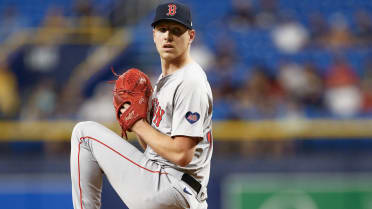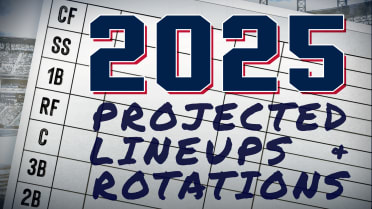5 reasons Davis is a top free-agent closer
Free agency is underway, and before the dominos start to fall into place, MLB.com is here to help you see some of the biggest names available on the market through a more focused lens.
Relief pitchers continue to take on an increasingly important role in today's game, and perhaps no available reliever is more coveted than right-hander Wade Davis.
• Hot Stove Tracker
The 32-year-old, who went 4-2 with a 2.30 ERA with 79 strikeouts in 58 2/3 innings for the Cubs in 2017, has been simply dominant over the past four seasons with Chicago and Kansas City. With a 23-6 record, 1.45 ERA and 313 strikeouts in 241 1/3 frames since the start of '14 -- when he converted to being a reliever full-time -- Davis has been a true difference-maker for whichever club lands his services.
Here's a look at five Statcast™ metrics that help show why Davis figures to be one of the most highly valued relievers in free agency:
1. xBA in high-leverage situations
Davis had to pitch his way out of a fair share of tight spots this past season -- he's one of 35 relievers who pitched 100 or more at-bats with the tying or go-ahead run on base or at the dish. It's what the premier firemen are asked to do -- put out the flames. The closer handled such situations quite admirably for Chicago last season, proving to be one of the best escape artists in the game. Based on his strikeouts and the quality of contact he allowed, Davis' expected batting average against in those potentially game-changing situations was just .169, the fourth lowest among relievers in that 35-man group.
Lowest xBA allowed with tying/go-ahead run on base/at plate, RP, 2017
Min. 100 AB with tying/go-ahead run on base/at plate
- Kenley Jansen: .141
- Corey Knebel: .150
- Andrew Miller: .168
4. Wade Davis: .169 - Edwin Diaz: .173
2. Chase rate
Getting hitters to swing at "pitcher's pitches" -- instead of those they can drive -- is a valuable skill for not only racking up strikeouts, but also producing weak contact. Davis got opposing batters to chase pitches out of the zone about as well as any reliever in baseball in 2017 with his cutter, a pitch that greats like former Yankees closer Mariano Rivera and current Dodgers closer Kenley Jansen have used to dominate. Davis utilizes a similar tactic, despite throwing the pitch less frequently than those two.
Highest chase rate on cutters, RP, 2017
Min. 100 swings
- Richard Bleier: 46.7%
- Brandon Morrow: 45.9%
- Tommy Hunter: 45.2%
- Carlos Torres: 44.4%
- Dominic Leone: 42.7%
6. Wade Davis: 40.3%
3. Whiff rate
That same cutter Davis uses to induce swings on pitches out of the zone is one that still generates a ton of swing and misses when thrown in the strike zone. Davis can use the pitch to get hitter to chase, but also uses it to challenge them -- and he does it with great success. Davis' 28-percent swing-and-miss rate on in-zone cutters ranked third in the Majors behind only Jansen and the Brewers' Jacob Barnes.
Highest percentage of swings and misses on cutters, RP, 2017
Min. 100 swings
- Kenley Jansen: 29.2%
- Jacob Barnes: 28.5%
3. Wade Davis: 28.0% - Dominic Leone: 27.5%
- George Kontos: 26.6%
4. Average exit velocity against
Davis' four-seam fastball has been one of the best in the game since Statcast™ debuted in 2015 in terms of inducing weak contact. Among relievers who have at least 150 batted balls versus their fastball over the past three seasons, Davis' 85.6-mph average exit velocity against is tied for seventh best. Combining the lack of hard contact off him overall, plus his penchant for strikeouts, Davis is about as good as they come when trying to close out a game.
Average exit velocity on 4-seam fastballs, RP, since 2015
Min. 150 batted balls - C.J. Edwards: 83.2 mph
- Sean Doolittle: 84.6 mph
- Robbie Ross Jr.: 85.1 mph
- Jonathan Broxton: 85.2 mph
- Joe Biagini: 85.3 mph
- Dan Jennings: 85.5 mph
T-7. Wade Davis: 85.6 mph
T-7. Jumbo Diaz: 85.6 mph
5. wOBA vs. lefties
One of managers' key reference points for deciding which reliever to bring in is their pitchers' splits against left-handed and right-handed batters. However, the best are brought in no matter the handedness of the batter or pitcher. Davis fits that bill, as he held left-handed hitters to just a .493 OPS in 2017. Weighted on-base average (wOBA) -- which Statcast™ calculates using a combination of exit velocity and launch angle, plus walks and strikeouts -- is yet another metric that displays Davis' dominance versus left-handers despite being a right-handed hurler. Since the start of '15, only the Yankees' Chad Green and former Cubs teammate Edwards have a lower xOBA against vs. left-handed hitters among right-handed pitchers.
Lowest wOBA among RHP vs. LHB, RP, since 2015
Min. 100 batted balls
- Chad Green: .175
- Carl Edwards Jr.: 213
3. Wade Davis: .222 - Will Harris: .229
- Player Page for David Robertson: .230
Oliver Macklin is a reporter for MLB.com based in Washington, D.C. Follow him on Twitter at @basebollie.



